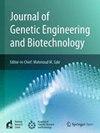RNA测序转录组分析揭示了Gemini纳米姜黄素对p53突变HT-29结直肠癌细胞的新靶点
IF 2.8
Q3 Biochemistry, Genetics and Molecular Biology
Journal of Genetic Engineering and Biotechnology
Pub Date : 2025-08-20
DOI:10.1016/j.jgeb.2025.100548
引用次数: 0
摘要
结直肠癌在世界范围内被认为是一种高死亡率的侵袭性肿瘤。研究表明,Gemini纳米姜黄素(Gemini- cur)可以影响结直肠癌细胞的生存能力。然而,其毒性背后的细胞和分子机制是有争议的。在这里,我们计划通过RNA测序来解开纳米姜黄素在p53突变HT-29癌细胞上的潜在新靶点。方法HT-29细胞培养后,用适当剂量的Gemini-Cur孵育24 h,提取总RNA,构建cDNA文库并测序。采用DESeq2工具将reads归一化并检测差异表达基因(DEGs)。利用富集工具进行基因本体(GO)鉴定在该条件下受影响的生物过程(BP)、细胞成分(CC)和分子功能(MF)。用STRING构建了1200个deg的PPI网络,用cytocape进行可视化,并用MCODE进行分析。结果经DEGs筛选,在未处理和处理的癌细胞间共获得1309个基因,其中p值<; 0.05 & log2 FC < 1)上调基因479个,p值<; 0.05 & log2 FC < 1)下调基因63个。然后,deg被分配到207个氧化石墨烯术语,包括许多细胞途径,如内质网(ER)相关过程。最终,542个上调和下调基因被定位到67个反应组通路上。通路分析表明,Gemini-Cur调节多种通路,包括内质网应激反应和转运蛋白相关基因。使用MCODE,三个模块被显著识别,得分≥1,节点≥1。结论纳米姜黄素可能通过调节内质网反应、转运蛋白相关基因等不同途径影响HT-29结直肠癌细胞。需要更多的研究来揭示这些途径的分子机制和蛋白质,这些途径可能被认为是结直肠癌的新治疗靶点。本文章由计算机程序翻译,如有差异,请以英文原文为准。
Transcriptome profiling by RNA sequencing reveals novel targets of Gemini nano curcumin on p53-mutant HT-29 colorectal cancer cells
Introduction
Colorectal cancer is considered as an aggressive tumor with high mortality in the world. It has been shown that Gemini Nano-Curcumin (Gemini-Cur) affects viability of colorectal cancer cells. Nevertheless, the cellular and molecular mechanisms underlying its toxicity are debatable. Here, we planned to untangle the potential novel targets for nanocurcumin on p53-mutant HT-29 cancer cells by employing RNA sequencing.
Methods
After cultivation, HT-29 cell were incubated with appropriate doses of Gemini-Cur for 24 h. Total RNA was extracted, cDNA library was constructed and sequenced. The DESeq2 tool were employed to normalize reads and detect differentially expressed genes (DEGs). The enrichR tool was employed to do Gene Ontology (GO) & identify biological processes (BP), cellular components (CC) and molecular functions (MF) that are impacted in the condition. The PPI network was constructed of 1200 DEGs using STRING, visualized by Cytoacape and analyzed with MCODE.
Results
After DEGs screening, 1309 genes between untreated and treated cancer cells were obtained including 479 upregulated with P-value < 0.05 & log2 FC > 1) as well as 63 downregulated genes with P-value < 0.05 and log2 FC < −1). Then, DEGs were assigned to 207 GO terms including numerous cellular pathways such as endoplasmic reticulum (ER)-related processes. Finally, 542 up and downregulated genes were mapped to 67 reactome pathways. The pathway analysis illustrated that Gemini-Cur modulates numerous pathways including ER stress response- and transporter-related genes. Using MCODE, Three modules were significantly identified with scores ≥ 1 and nodes ≥ 1.
Conclusion
Our data reveal that nanocurcumin might affects HT-29 colorectal cancer cells through modulating different pathways such as endoplasmic reticulum response, and transporter-related genes. More studies necessitate to unravel the molecular mechanisms and proteins involved in these pathways that could be considered as novel therapeutic targets in colorectal cancer.
求助全文
通过发布文献求助,成功后即可免费获取论文全文。
去求助
来源期刊

Journal of Genetic Engineering and Biotechnology
Biochemistry, Genetics and Molecular Biology-Biotechnology
CiteScore
5.70
自引率
5.70%
发文量
159
审稿时长
16 weeks
期刊介绍:
Journal of genetic engineering and biotechnology is devoted to rapid publication of full-length research papers that leads to significant contribution in advancing knowledge in genetic engineering and biotechnology and provide novel perspectives in this research area. JGEB includes all major themes related to genetic engineering and recombinant DNA. The area of interest of JGEB includes but not restricted to: •Plant genetics •Animal genetics •Bacterial enzymes •Agricultural Biotechnology, •Biochemistry, •Biophysics, •Bioinformatics, •Environmental Biotechnology, •Industrial Biotechnology, •Microbial biotechnology, •Medical Biotechnology, •Bioenergy, Biosafety, •Biosecurity, •Bioethics, •GMOS, •Genomic, •Proteomic JGEB accepts
 求助内容:
求助内容: 应助结果提醒方式:
应助结果提醒方式:


